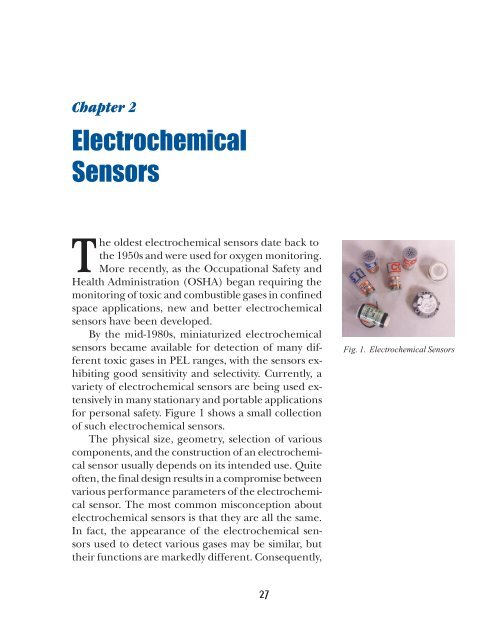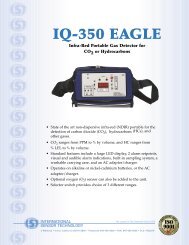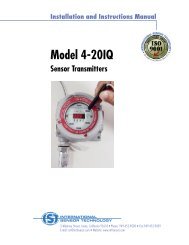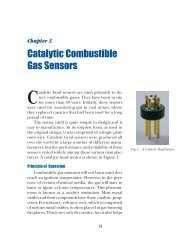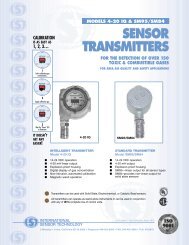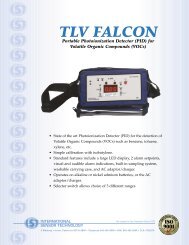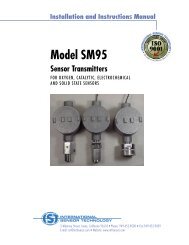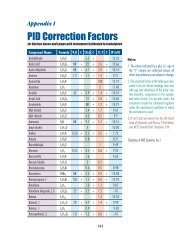Chapter 2 Electrochemical Sensors - International Sensor Technology
Chapter 2 Electrochemical Sensors - International Sensor Technology
Chapter 2 Electrochemical Sensors - International Sensor Technology
Create successful ePaper yourself
Turn your PDF publications into a flip-book with our unique Google optimized e-Paper software.
<strong>Chapter</strong> 2<br />
<strong>Electrochemical</strong> <strong><strong>Sensor</strong>s</strong><br />
<strong>Chapter</strong> 2<br />
<strong>Electrochemical</strong><br />
<strong><strong>Sensor</strong>s</strong><br />
The oldest electrochemical sensors date back to<br />
the 1950s and were used for oxygen monitoring.<br />
More recently, as the Occupational Safety and<br />
Health Administration (OSHA) began requiring the<br />
monitoring of toxic and combustible gases in confined<br />
space applications, new and better electrochemical<br />
sensors have been developed.<br />
By the mid-1980s, miniaturized electrochemical<br />
sensors became available for detection of many different<br />
toxic gases in PEL ranges, with the sensors exhibiting<br />
good sensitivity and selectivity. Currently, a<br />
variety of electrochemical sensors are being used extensively<br />
in many stationary and portable applications<br />
for personal safety. Figure 1 shows a small collection<br />
of such electrochemical sensors.<br />
The physical size, geometry, selection of various<br />
components, and the construction of an electrochemical<br />
sensor usually depends on its intended use. Quite<br />
often, the final design results in a compromise between<br />
various performance parameters of the electrochemical<br />
sensor. The most common misconception about<br />
electrochemical sensors is that they are all the same.<br />
In fact, the appearance of the electrochemical sensors<br />
used to detect various gases may be similar, but<br />
their functions are markedly different. Consequently,<br />
Fig. 1. <strong>Electrochemical</strong> <strong><strong>Sensor</strong>s</strong><br />
27
Hazardous Gas Monitors<br />
Gas Molecules Micro Ammeter<br />
Anode<br />
Cathode<br />
+ –<br />
Electrolyte<br />
Fig. 2 Basic <strong>Sensor</strong><br />
one can expect varying performance from each of<br />
these sensors, in terms of sensitivity, selectivity, response<br />
time, and operating life.<br />
For example, a low concentration gas sensor with<br />
very high sensitivity uses a coarse-porosity hydrophobic<br />
membrane and less restricted capillary to allow more<br />
gas molecules to pass through to produce enough signal<br />
for better sensitivity. However, this design also allows<br />
more of the electrolyte’s water molecules to escape<br />
out to the environment. In other words, an electrochemical<br />
sensor with high sensitivity would have a<br />
relatively short operating life due to evaporation of<br />
moisture through the porous membrane.<br />
Similarly, the electrolyte composition and the sensing<br />
electrode material is selected based on the chemical<br />
reactivity of the target gas. By careful selection of<br />
the electrolyte and/or the sensing electrode, one can<br />
achieve the selectivity towards the target gas, but the<br />
sensitivity may be reduced.<br />
In summary, different electrochemical sensors may<br />
appear very similar, but are constructed with different<br />
materials including such critical elements as sensing<br />
electrodes, electrolyte composition, and porosity<br />
of hydrophobic barriers. Additionally, some electrochemical<br />
sensors use external electrical energy to<br />
make them reactive to the target gas. All components<br />
of the sensors play a crucial role in determining the<br />
overall characteristics of the sensors.<br />
Capillary<br />
Diffusion<br />
Barrier<br />
Hydrophobic<br />
Membrane<br />
Principle of Operation<br />
Sensing Electrode<br />
Reference Electrode<br />
Counter Electrode<br />
Electrolyte<br />
Fig. 3 Typical <strong>Electrochemical</strong> <strong>Sensor</strong> Setup<br />
<strong>Electrochemical</strong> sensors operate by reacting with<br />
the gas of interest and producing an electrical<br />
signal proportional to the gas concentration.<br />
A typical electrochemical sensor consists<br />
of a sensing electrode (or working electrode),<br />
and a counter electrode separated by a<br />
thin layer of electrolyte, Figure 3.<br />
Gas that comes in contact with the sensor<br />
28
<strong>Chapter</strong> 2<br />
<strong>Electrochemical</strong> <strong><strong>Sensor</strong>s</strong><br />
first passes through a small capillary-type opening and<br />
then diffuses through a hydrophobic barrier, and eventually<br />
reaches the electrode surface. This approach is<br />
adopted to allow the proper amount of gas to react at<br />
the sensing electrode to produce a sufficient electrical<br />
signal while preventing the electrolyte from leaking<br />
out of the sensor, Figure 4.<br />
The gas that diffuses through the barrier reacts at<br />
the surface of the sensing electrode involving either an<br />
oxidation or reduction mechanism. These reactions are<br />
catalyzed by the electrode materials specifically developed<br />
for the gas of interest.<br />
With a resistor connected across the electrodes, a<br />
current proportional to the gas concentration flows between<br />
the anode and the cathode. The current can be<br />
measured to determine the gas concentration. Because<br />
a current is generated in the process, the electrochemical<br />
sensor is often described as an amperometric gas sensor<br />
or a micro fuel cell.<br />
Importance of a Reference Electrode. For a sensor<br />
requiring an external driving voltage, it is important<br />
to have a stable and constant potential at the sensing<br />
electrode. In reality, the sensing electrode potential<br />
does not remain constant due to the continuous electrochemical<br />
reaction taking place on the surface of the<br />
electrode. It causes deterioration of the performance<br />
of the sensor over extended periods of time. To improve<br />
the performance of the sensor, a reference electrode is<br />
introduced.<br />
This reference electrode is placed within the electrolyte<br />
in close proximity to the sensing electrode. A<br />
fixed stable constant potential is applied to the sensing<br />
electrode. The reference electrode maintains the<br />
value of this fixed voltage at the sensing electrode. No<br />
current flows to or from the reference electrode. The<br />
gas molecules react at the sensing electrode and the<br />
current flow between the sensing and the counter electrode<br />
is measured and is typically related directly to<br />
Gas<br />
Water and Gas<br />
Hydrophobic<br />
Membrane<br />
Electrolyte<br />
Fig. 4 Hydrophobic Membrane:<br />
prevents liquid electrolyte from<br />
leaking out.<br />
29
Hazardous Gas Monitors<br />
the gas concentration. The value of the voltage applied<br />
to the sensing electrode makes the sensor specific to the<br />
target gas.<br />
The micro fuel cell-type electrochemical sensors do not<br />
require an external driving voltage. For example, an electrochemical<br />
sensor specific to oxygen has an anode, either<br />
Pb or Cd, that supplies electrons for the reduction of<br />
oxygen at the cathode. During the oxidation of the anode,<br />
the electrons are released which then travel via an<br />
external circuit to the cathode where oxygen molecules<br />
consume the electrons as follows:<br />
In acidic electrolyte<br />
Oxidation at the anode: 2Pb + 2H 2<br />
O → 2PbO + 4H + + 4e -<br />
Reduction at the cathode:<br />
O 2<br />
+ 4H + + 4e - → 2H 2<br />
O<br />
In basic electrolyte<br />
Oxidation at the anode: 2Pb + 4OH - → 2PbO + 2H 2<br />
O + 4e -<br />
Reduction at the cathode: O 2<br />
+ 2H 2<br />
O + 4e - → 4OH -<br />
The overall reaction in both cases is: 2Pb + O 2<br />
→ 2PbO.<br />
These types of sensors do not require a reference electrode.<br />
Major Components<br />
An electrochemical sensor consists of the following major<br />
components:<br />
A. Gas Permeable Membrane (also called hydrophobic<br />
membrane): This is used to cover the sensor’s sensing<br />
(catalyst) electrode and, in some instances, to<br />
control the amount of gas molecules reaching the<br />
electrode surface. Such barriers are typically made<br />
of thin, low-porosity Teflon membranes. Such sensors<br />
are called membrane clad sensors. Alternatively,<br />
the sensing electrode is covered with a high-porosity<br />
Teflon and the amount of gas molecules reaching<br />
the electrode surface is controlled by a capil-<br />
30
<strong>Chapter</strong> 2<br />
<strong>Electrochemical</strong> <strong><strong>Sensor</strong>s</strong><br />
lary. Such sensors are referred to as capillary-type<br />
sensors. Besides offering a mechanical protection to<br />
the sensor, the membrane performs the additional<br />
function of filtering out unwanted particulates. Selecting<br />
the correct pore size of the membrane and<br />
capillary is necessary to transfer the proper amount<br />
of gas molecules. The pore size should be such as<br />
to allow enough gas molecules to reach the sensing<br />
electrode. The pore size should also prevent liquid<br />
electrolyte from leaking out or drying out the sensor<br />
too quickly.<br />
B. Electrode: The selection of the electrode material<br />
is very important. It is a catalyzed material<br />
which performs the half cell reaction over a long<br />
period of time. Typically, the electrode is made<br />
from a noble metal, such as platinum or gold, and<br />
catalyzed for an effective reaction with gas molecules.<br />
Depending on the design of the sensor, all<br />
three electrodes can be made of different materials<br />
to complete the cell reaction.<br />
C. Electrolyte: The electrolyte must facilitate the cell<br />
reaction and carry the ionic charge across the electrodes<br />
efficiently. It must also form a stable reference<br />
potential with the reference electrode and be<br />
compatible with materials used within the sensor.<br />
If the electrolyte evaporates too quickly, the sensor’s<br />
signal will deteriorate.<br />
D. Filter: Sometimes a scrubber filter is installed in<br />
front of the sensor to filter out unwanted<br />
gases. There is a limited selection<br />
of filters, each with different de-<br />
Barrier<br />
Capillary<br />
Diffusion<br />
grees of effectiveness. The most commonly<br />
used filter medium is activated<br />
charcoal, as shown in Figure 5. The activated<br />
charcoal filters out most chemicals<br />
with the exception of carbon monoxide<br />
and hydrogen gases. By properly<br />
selecting the filter medium, an elec-<br />
Charcoal Filter<br />
Sensing Electrode<br />
Reference Electrode<br />
Counter Electrode<br />
Electrolyte<br />
Fig. 5 Filtering with Activated Charcoal<br />
31
Hazardous Gas Monitors<br />
Typical Gases and the<br />
Range of Measurement of<br />
<strong>Electrochemical</strong> <strong><strong>Sensor</strong>s</strong><br />
GAS NAME<br />
PPM RANGE<br />
Ammonia, NH 3<br />
10<br />
Arsenic Hydride, AsH 3<br />
1<br />
Bromine, Br 2<br />
30<br />
Carbon Monoxide, CO 300<br />
Chlorine, Cl 2<br />
5<br />
Chlorine Dioxide, ClO 2<br />
5<br />
Diborane, B 2<br />
H 6<br />
1<br />
Fluorine, F 2<br />
10<br />
Germane, GeH 4<br />
2<br />
Hydrogen, H 2<br />
2000<br />
Hydrogen Chloride, HCl 30<br />
Hydrogen Cyanide, HCN 30<br />
Hydrogen Fluoride, HF 10<br />
Hydrogen Sulfide, H 2<br />
S 30<br />
Nitric Oxide, NO 100<br />
Nitrogen Dioxide, NO 2<br />
50<br />
Oxygen<br />
ppm levels to<br />
100% by vol.<br />
Ozone, O 3<br />
3<br />
Phosphine, PH 3<br />
1<br />
Silane, SiH 4<br />
50<br />
Sulfur Dioxide, SO 2<br />
100<br />
trochemical sensor can be made more selective<br />
to its target gases.<br />
Choosing the suitable materials for the above<br />
components, and arranging the geometry of all these<br />
components to determine the optimum operating performance<br />
presents a challenge to scientists. Minor<br />
variations in the details of the sensor design can have<br />
a profound influence on the sensor’s accuracy, response<br />
time, sensitivity, selectivity, and life expectancy.<br />
Importance of Oxygen. The reactions at the sensing<br />
electrode(anode) for some gases are as follows:<br />
CO + H 2<br />
O → CO 2<br />
+ 2H + + 2e -<br />
H 2<br />
S + 4H 2<br />
O → H 2<br />
SO 4<br />
+ 8H + + 8e -<br />
NO + 2H 2<br />
O → HNO 3<br />
+ 3H + + 3e -<br />
H 2<br />
→ 2H + + 2e -<br />
2HCN + Au → HAu(CN) 2<br />
+ H + + e -<br />
Simultaneously, the reactions at the counter electrode<br />
(cathode) need oxygen molecules to complete<br />
the process:<br />
O 2<br />
+ 4H + + 4e - → 2H 2<br />
O<br />
An inadequate supply of oxygen to complete the<br />
reaction will shorten the life of the sensors, hence the<br />
sensors will not operate properly.<br />
<strong><strong>Sensor</strong>s</strong> involving a reduction reaction of the target<br />
gas—such as the reduction of nitrogen dioxide,<br />
chlorine, and ozone—at the cathode produce water<br />
as a byproduct. At the anode, water is simultaneously<br />
oxidized. Such sensors do not require the presence<br />
of oxygen to function properly, as shown by the following:<br />
NO 2<br />
+ 2H + + 2e - → NO + H 2<br />
O<br />
Cl 2<br />
+ 2H+ + 2e - → 2HCl<br />
O 3<br />
+ 2H + + 2e - → O 2<br />
+ H 2 O<br />
32
<strong>Chapter</strong> 2<br />
<strong>Electrochemical</strong> <strong><strong>Sensor</strong>s</strong><br />
Characteristics<br />
There are many different ways that electrochemical<br />
sensors are constructed, depending both on the<br />
gas to be detected as well as the manufacturer. However,<br />
the main characteristics of the sensors are essentially<br />
very similar. Following are some of the common<br />
characteristics of electrochemical sensors:<br />
1. With a three-electrode sensor, there is normally<br />
a jumper which connects the working<br />
and reference electrodes. If it is removed during<br />
storage, it will take a long time for the sensor<br />
to stabilize and be ready to be used. Some<br />
sensors require a bias voltage between the electrodes,<br />
and in such cases, the sensors are<br />
shipped from the factory with a nine-volt battery<br />
powered electronic circuit. It takes anywhere<br />
from thirty minutes to twenty-four hours<br />
for the sensor to stabilize, and it will continue<br />
to stabilize over a three-week period.<br />
When installed in a portable or stationary<br />
instrument, the sensor cannot be removed<br />
from power for an appreciable amount of time.<br />
It is wise to double-check the instrument before<br />
use if batteries or power were removed at<br />
some point. The portable instrument’s circuitry<br />
provides a small current needed to<br />
maintain the sensor in the ready-to-use condition,<br />
even if the instrument is turned off.<br />
Two-electrode sensors do not require any<br />
bias voltage. For example, oxygen sensors do<br />
not require a bias voltage.<br />
2. Most of the toxic gas sensors require a small<br />
amount of oxygen to function properly. There<br />
is a vent hole on the side or back of the sensor<br />
for this purpose. It is wise to double-check with<br />
the manufacturer in applications that use nonoxygen<br />
background gas.<br />
33
Hazardous Gas Monitors<br />
3. Electrolyte within the sensor cell is an aqueous<br />
solution separated by a hydrophobic barrier<br />
which will not allow the aqueous solution to<br />
leak out. However, water vapor can pass<br />
through, just as other gas molecules can. In<br />
high humidity conditions, prolonged exposure<br />
can cause excessive water to build up and create<br />
leakage. In low humidity conditions, the<br />
sensor can dry out. <strong><strong>Sensor</strong>s</strong> that are designed<br />
to monitor high gas concentrations have less<br />
porous barriers to limit the amount of gas<br />
molecules that pass through, and therefore are<br />
not affected by the humidity as much as sensors<br />
that are used to monitor low gas concentrations,<br />
which have more porous barriers and<br />
allow a more free exchange of water molecules.<br />
List of Typical Gas<br />
Interference Ratios<br />
for CO <strong><strong>Sensor</strong>s</strong><br />
Gas<br />
Without Filter With Filter<br />
H 2 S 0.3:1 10:1<br />
SO 2 2:1 20:1<br />
NO 3.3:1 10:1<br />
NO 2 1.6:1 10:1<br />
H 2 2:1 2:1<br />
The higher the interference ratio,<br />
the less effect an interference<br />
gas has on the sensor.<br />
Pressure and Temperature<br />
<strong>Electrochemical</strong> sensors are minimally affected by<br />
pressure changes. However, it is important to keep the<br />
entire sensor within the same pressure since differential<br />
pressure within the sensor can cause sensor damage.<br />
<strong>Electrochemical</strong> sensors are also quite sensitive<br />
to temperature and, therefore, the sensors are typically<br />
internally temperature-compensated. However,<br />
it is better to keep the sample temperature as stable<br />
as possible.<br />
In general, when the temperature is above 25°C,<br />
the sensor will read higher; when it is below 25°C, it<br />
will read lower. The temperature effect is typically 0.5%<br />
to 1.0% per degree centigrade, depending on the<br />
manufacturer and type of sensor.<br />
Selectivity<br />
<strong>Electrochemical</strong> sensors are generally fairly selective<br />
to the target gas they are designed for. The degree<br />
of selectivity depends on the type of sensor, the<br />
target gas, and the concentration of gas the sensor is<br />
34
<strong>Chapter</strong> 2<br />
<strong>Electrochemical</strong> <strong><strong>Sensor</strong>s</strong><br />
designed to detect. The best electrochemical sensor<br />
is for the detection of O 2<br />
, which has good selectivity,<br />
is very reliable, and has a long life expectancy. Other<br />
electrochemical sensors are subject to interference<br />
from other gases. A typical list of interference ratios<br />
for CO sensors is shown on page 34 as an example.<br />
The higher the ratio, the less the effect of interference<br />
gas on the sensor. The interference data are<br />
taken using relatively low gas concentrations. In actual<br />
applications, interference concentrations can be<br />
quite high, causing false readings and/or alarms.<br />
Life Expectancy<br />
The life expectancy of an electrochemical sensor<br />
depends on several factors, including the gas to be<br />
detected and the environmental conditions in which<br />
the sensor is used.<br />
Generally, a one- to three-year life expectancy is<br />
specified. In reality, the life expectancy will be highly<br />
dependent on the total amount of gas exposed to<br />
the sensor during its life, as well as other environmental<br />
conditions, such as temperature, pressure and<br />
humidity.<br />
Typical Toxic Gas<br />
<strong>Electrochemical</strong><br />
<strong>Sensor</strong> Specification<br />
<strong>Sensor</strong> Type: 2 or 3 electrodes; mostly 3<br />
electrodes<br />
Range: 2-10 times permissible exposure limit<br />
Life Expectancy: 12 to 24 months normal;<br />
depends on manufacturer and sensor<br />
Temperature Range: –40 o C to +45 o C<br />
Relative Humidity: 15-95% noncondensing<br />
Response Time T 80<br />
: < 50 sec.<br />
Long Term Drift: drift down 2% per month<br />
Summary<br />
<strong>Electrochemical</strong> sensors require very little power<br />
to operate. In fact, their power consumption is the<br />
lowest among all sensor types available for gas monitoring.<br />
For this reason, the sensors are widely used in<br />
portable instruments that contain multiple sensors.<br />
They are the most popular sensors in confined space<br />
applications.<br />
A sensor’s life expectancy is predicted by its manufacturer<br />
under conditions that are considered normal.<br />
However, the life expectancy of the sensor is highly<br />
dependent on the environmental contaminants, temperature,<br />
and humidity to which it is exposed.<br />
35


